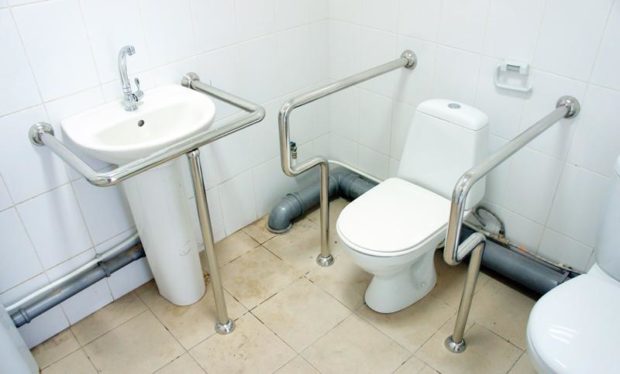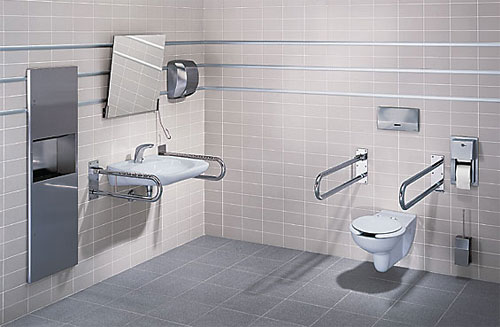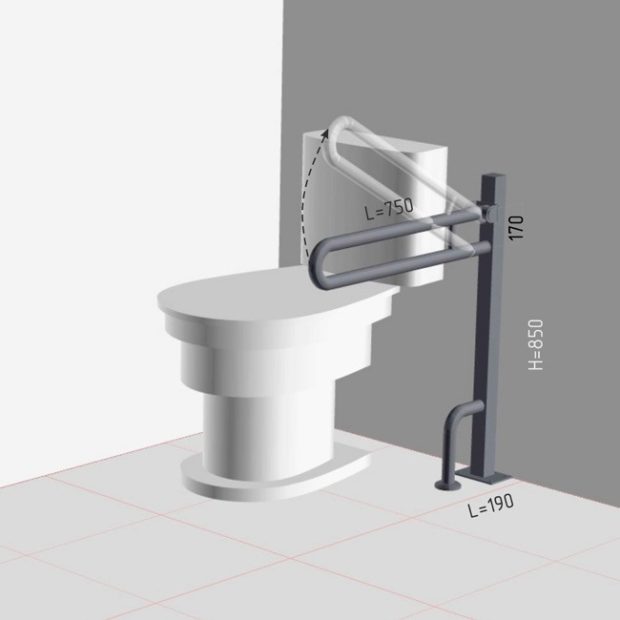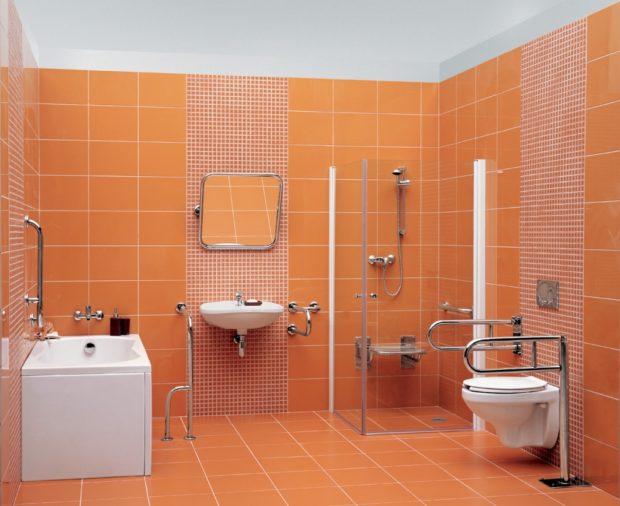Hands for the disabled Toilet and bath: 5 tips for choosing
Taking a bath or going to the toilet for a person with disabilities is difficult not only physically, but also psychologically, because to perform such intimate procedures you have to call someone for help. Fortunately, there are a lot of devices that allow you to solve the problem in a complex way. One of them is the handrails, which are attached in the bathrooms and give a person a powerful support. You have repeatedly met similar people in public buildings, incl. in the toilets. You can put handrails for the disabled in the apartment. The main thing is to choose the right material, type of construction and think over the installation sites.

WHERE ARE HANDRAILS NEEDED?
Handrails are placed wherever a person has to bend down, sit down and get up, i.e. near the bath / shower, sink and toilet. We note right away that the handrails are ideal for weakened and sick people who can move around on their own, have the ability to independently perform all hygiene procedures, they only require a little help. Also handrails will help people moving in a wheelchair.
To make the bathroom ideally suited to the requirements of a person with a disability or an elderly person, consider placing handrails in the following places:
- on both sides of the toiletso that the load is evenly distributed on two hands. Ideally, one of the handrails is swivel or hinged to facilitate access to the toilet and make it possible to use it even for a person in a wheelchair. If the patient can move himself, then both handrails near the toilet can be stationary;

- near the sink , it is best to use a girdle model - this will be most convenient for a disabled person, but two handrails on the sides of the sink are also allowed - this option will be even more convenient for wheelchair users. Fastening is carried out either only on the wall, or on the wall and floor;

- There are two types of handrails around the bathtub . The first is necessary to help the disabled person climb into the bath, it must be long enough so that it can be comfortably grabbed when moving from a wheelchair and from a standing position. If a person is practically deprived of physical activity, it would be appropriate to equip the bathtub with a special lift. A handrail may also come in handy. Secondthe type of handrail is attached to the wall along the bathroom, it can be long and short, horizontal and vertical crossbars. They are necessary to ensure the safety of movement during washing, help to move from a lying position to a sitting position, to get up. Such handrails can be placed in the shower. There, by the way, you can fix the folding seat. Additionally, do not forget to lay an anti-slip mat on the bottom of the bathtub or shower tray.

On the page https://healthstore.lv/lv/ishop/invalidu-tehnika/tualetes-kresli/rolatori/ you can find different types of handrails. All products comply with state standards, are made of stainless steel with anti-slip coating. There are stationary, rotary and mobile models, as well as handrails.
PROS AND CONS OF HANDRAILS
You don’t have to talk about the pros and cons of handrails when there is a real need for them, but still you need to be aware of their real disadvantages in order to be prepared and think through the nuances of installation, interior design, ease of use of the bathroom, etc. in advance.
The advantages of handrails for the disabled are obvious:
- a person with disabilities gets the opportunity to take care of himself, which simplifies his care and gives the patient psychological comfort;
- reliability. A good and correctly selected handrail can withstand a load of up to 160 kg;
- durability. The handrails do not rust, therefore they can be safely used in the bathroom, and for quite a long time;
- relative ease of operation and maintenance;
- variety, so you can choose the right model for almost any user, and even more - harmoniously integrate the handrails into the interior.
Disadvantages :
- difficult to install in a small bathroom and toilet;
- additional load is created on the floor and walls;
- decent cost.

TYPES OF HANDRAILS
Depending on the indicators of mobility, the handrails in the bathroom for the disabled are:
- stationary - the most reliable and strong, fastening is carried out on the wall and / or floor. They can be mounted around the toilet, sink and bathtub, but require sufficient space, so they may not fit in a small bathtub. For people with excess body weight, reinforced handrails with double fastening have been developed. Such structures can be mounted both along the walls and perpendicular to them;

- folding and rotary are installed on one side of the toilet if the disabled person moves in a wheelchair, since if there are only stationary structures, it will be impossible to use the toilet;

- on suction cups - a modern invention that was supposed to be a salvation for a family where there is an elderly person or a disabled person. The idea is that the handrail is attached to the wall with silicone or rubber suction cups. It is not necessary to make holes in the wall or floor, and if necessary, the handrail is instantly dismantled. Manufacturers assure the reliability of suction cups, but such a handrail is unlikely to withstand an overweight person. Moreover, even with people of normal build, there were often situations when the handrail simply came off. Conclusion - this is a traumatic, impractical and short-lived product that is better not to be used by anyone;

- a mobile handrail will help a disabled person not only use plumbing, but also move around. This is a fairly massive product, but it will be possible to get by with one - you do not have to install separate handrails around the bathtub, toilet bowl and sink. Minus - in some cases it will not be particularly convenient, not suitable for everyone;
- handrail-steps are somewhat reminiscent of the previous design, since they are not attached to either the floor or walls. The device not only creates additional support for the disabled person, but also makes it easier for him to get into the bath. There are models with one and two steps. A two-step handrail is more stable and comfortable, but also heavier.

HANDRAIL MATERIAL
We will not discover America if we say that the strength, durability and safety of a handrail is 50% dependent on what material it is made of. There are several options:
- Stainless steel is the most reliable and durable product. They tolerate constant exposure to moisture and disinfectants, and thanks to the coating with nylon or other material, their surface becomes non-slip. Additional coverage may be absent, but then the handrail is corrugated so that the hand does not slip in any case;
- steel is not the best option, as the material will corrode very quickly. Steel handrails are often chrome plated. While new, these handrails look decent, but the coating peels off quickly. Steel handrails are inexpensive, and this is their only advantage. It makes sense to take them only with a very modest budget;
- brass is an expensive material, but if you need a handrail for an obese person, then it is better to stop at this option, because such a product can become a support for a person up to 160 kg;
- plastic is not the most reliable option, even though impact-resistant reinforced plastic is usually used. The same handrails on suction cups are made from it.

MOUNTING FEATURES
It is not difficult to install the handrails yourself, but you must strictly follow the installation instructions so that the structure is safe and able to withstand the load declared by the manufacturer. Always take into account the individual characteristics of a person, incl. height, degree of mobility, supporting arm.
As a rule, a set with a handrail has all the necessary fasteners, so you will need a minimum set of tools - a tape measure and a level, a marker, a puncher. It happens that the handrail was sold in a minimum configuration, and you will additionally have to buy racks, brackets, plugs, tees, hinges and bends.
The sequence of work is as follows:
- measurements are carefully taken, the places where the handrails will be installed are determined, there is an agreement with the person who will use these handrails;
- markings are made on the wall and / or floor near the toilet, sink and bath, everything is checked by level. At this stage, you can attach handrails to future attachment points and let the patient re-evaluate their location. The handrail is attached to a load-bearing wall, if this is not possible, consider floor mounting. If this is also impossible, and it is necessary to mount the handrail on a plasterboard wall, then you cannot do without embedded elements;
- holes are drilled in the wall, a hammer drill is best suited for this. Dowels are fixed, handrails are attached;
- the final touch is the installation of plugs.
Make sure you've done a good installation. Check the strength of all fasteners, try to use plumbing devices, leaning on the handrails with the whole mass.
If possible, install a sink next to the toilet so that the disabled person can wash their hands without getting up. If a person moves in a wheelchair, then there should be at least 80 cm of free space next to the toilet so that you can safely drive up and change seats. On the side from which the disabled person will transfer, a folding or swivel handrail is installed. Make sure the floor is never wet or slippery.
